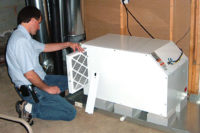The effective safekeeping of a museum’s collection is ensured by providing adequate security and environmental conditions. Environmental concerns are primarily the control of pollution, illumination, and temperature, but the leading threat is usually humidity.
What harm can a little water in the air do? The answer is plenty — with sensitive materials and the right circumstances. High humidities can encourage mold and other biological threats; rust and other corrosion occurs at high humidity levels. Low humidities may cause organic artifacts to crack. Fluctuating humidity levels can not only cause severe internal damage to furniture, they will also promote spalling of paint, loosening of joints, and surface damage in other composite materials (as materials expand and contract at different degrees).
Conservation science is the area of study that determines optimal conditions for display, although these are often a compromise between what is ideal (cold, dark, dry storage, in most cases) and what is possible (illuminated display in busy public spaces). Research has been ongoing for many decades, and as the science has developed, humidity targets for storage and display have been adjusted, sometimes with dramatic effect on the expectations of plant engineers and museum designers.
MUSEUM STANDARDS
From the mid-twentieth century until very recently, ideal conditions have been commonly expressed as a combination of about 70°F and 50 percent relative humidity (RH), with very little acceptable variation. (RH is the measure of how much water the air actually holds relative to how much it can hold.) With some hindsight, it has become clear that the adoption of these standards had more to do with what could be provided than what should be provided, and new, less severe standards are quickly coming into use. However, it remains true that improper humidity control, inappropriate or shifting temperatures, and airborne pollution are the enemies of most museum collections.
What is acceptable? The American Society of Heating, Refrigerating and Air-Conditioning Engineers (ASHRAE) recently updated the chapter on museum environments in its handbook, providing a range of conditions with accompanying expectations on those impacts on museum collections. Levels of control range from AA (where humidities and temperatures vary slightly and slowly), through D (where dampness alone is addressed). Engineers are encouraged to research the level of control needed, rather than simply go for a “one size fits all” standard. Museums are encouraged to make environmental control efforts a team decision. Humidity control is not only about collection care, it is a big part of any museum or gallery’s operating costs.
Humidity control is usually considered the most expensive aspect of environmental control. Evaporating or condensing water in or out of the air takes substantial energy. This energy investment is lost when fresh air is brought in to maintain healthy conditions and stale air is exhausted. While heat can often be recovered from exhaust air, the energy used in humidifying air is harder to conserve, and is usually lost. Recent studies show that for every halving of setpoints (say from ±10% to ±5%), the cost of controlling the environment in a museum doubles. This can have a substantial effect on already tight budgets.
And there’s more: Even where energy and finances exist to provide ideal conditions in a museum or gallery, the building envelope may not be able to withstand the stress of high humidities inside and winter cold without. Substantial differences in temperature and/or humidity can cause serious damage, both structural and biological (mold). This is especially true of older museums and historic houses.
MICROCLIMATE CONTROL
ASHRAE’s standards are generally used when designing whole gallery air conditioning using standard HVAC techniques. However, it is well known that when a museum artifact is protected by an enclosure, such as a tightly sealed showcase, only the air in the showcase needs to be controlled.
This has important implications on the provision of expensive humidity control since controlling humidity in showcases or storage cabinets, which occupy a tiny fraction of a room’s volume, is, in comparison, miniscule. Over the past 50 years, many methods have been developed, tried, and proven. Together, they are usually referred to as microclimate control.
Microclimate control begins with the creation of a tightly sealed enclosure. A microclimate controlled enclosure can be as small as a picture frame, or as large as an archive storage room. Microclimate control techniques are used in storage cabinets, and of course, in museum showcases. In general, enclosures suitable for microclimate control are never occupied or used by staff, and are very well sealed. With most microclimate enclosures having air exchange rates of less than one air change per day, these would not be comfortable working conditions.
A sealed enclosure prevents rapid changes in humidity, as well as preventing the entry of dust and gaseous pollutants. When a humidity buffer such as Keepsafe’s PROSorb (a silica gel compound) is included in a sealed enclosure, the humidity will tend to change slowly, if at all. This is a consequence of the buffer releasing and absorbing moisture as it equilibrates with the air in the enclosure, and is known as passive buffering. Showcases using passive buffering need to be carefully and regularly monitored, and the buffer must be removed and reconditioned as required. Showcases containing large quantities of natural buffering materials (such as paper or taxidermy) may not need silica gel-based compounds, but reduced amounts of PROSorb will still have a stabilizing effect.
Passive buffering is easily defeated by small leaks in the showcase, as buffering compounds have limited capacity to moderate humidity changes. Modern standards for showcases designed to use passive buffering call for less than one air change every 10 days. Enclosures that meet these standards are costly, and small changes in sealing (misalignment, damaged gasketing, etc.) can cause substantial changes in leakage rates after delivery. Other humidity control problems arise with large cases, where the volume and location of large quantities of buffering compound can be challenging.Small, self-contained active humidity control devices have been available to museums for over 30 years. Active humidity control devices are essentially miniature HVAC devices, usually capable of controlling only humidity levels. Early units consisted of a fan to move air to and from the case, and through the mechanism. Simple methods of humidifying (using wicks or water baths) and dehumidifying (using desiccants or cold plates) were used to adjust the case humidity. In more modern designs, air is carefully filtered and the humidity adjusted using dew point generators and electronic cooling.
For example, Keepsafe offers the Mini One, a microclimate generator that can be used to feed single or multiple cases. The Mini One uses a pump to propel air through the system, so it can be used up to 75 feet away from the showcases it is controlling. The Mini One can control a small case by delivering air at the desired humidity and simply displacing air from the enclosure. When very small showcases (such as framed and glazed works of art on the wall) are protected, one unit can provide enough air for dozens of frames, using a system of unobtrusive micro tubing for air delivery. For large showcases, the same unit can be modified to provide a flow of moist or dry air, thus increasing its effectiveness, and compensating for improper humidities due to leakage.
Many museums now use large, centrally located microclimate control devices. These larger units function by using only displacement positive pressure airflow. Each device produces a flow of air at the desired humidity, and displaces the air from multiple sealed enclosures. One such unit is Keepsafe’s new Maxi Sixty. This machine delivers a constant flow of humidity-tempered air to sealed display and storage cases, from a central location up to 500 feet distant. A single Maxi Sixty can protect over 10,000 cubic feet of display or storage cases.
Large central units have been in use for more than 15 years, and many museums (including The Field Museum in Chicago, The Newseum in Washington, and the Royal Ontario Museum in Toronto) rely on them to provide exacting conditions in their display cases. Again, savings on energy and operating costs can be very substantial; offsetting any costs for installation of units and air distribution systems.
Humidity control is central to the effective operation of a museum or gallery. Without appropriate control, both collections and buildings can be irretrievably damaged. Microclimate control provides a means for ensuring that artifacts can be stored and displayed safely, while maintaining museum humidity at comfortable levels.











